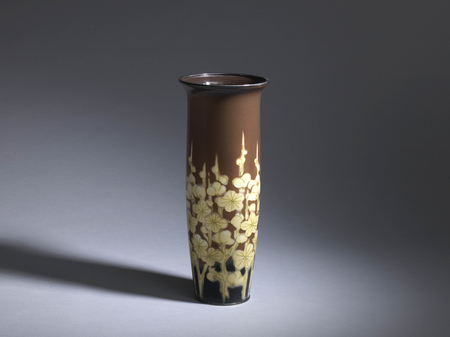Product Description
7495 A cloisonné enamel vase decorated in silver wire and musen (wireless) enamels with blossoming plum branches, silver rims, with a carved and reticulated wood stand
Seal: Andō mark (to the base)
Base stamped: jungin (pure silver)
Japan, Showa period, 20th century
Dimensions: H. 35 cm. x Diam. 14 cm. (14 x 5¾ in.); H. 38 cm. (15 in.) with stand
Tomobako (original box) inscribed:
Lid: Shippō gyokuyu baika-mon kabin (A cloisonné enamel vase with plum blossoms in semi-transparent glaze)
Andō shippōten zo (made by Ando workshop) with seal Ando kinsei (humbly made by Ando)
The Andō Shippō Workshop was founded in Nagoya in 1880 by Andō Jūbei (1876-1953), the firm’s famous innovator who was born in Aichi Prefecture as Jusaburō the eldest son of Murata Jūbei a manufacturer of smoking pipes. Upon the death of both his parents in 1877, the infant succeeded as the titular head of the family and took the ancestral name Andō Jūbei. His considerably older brother in law Maeda Matsukichi (1856-1945) as acting head of the family took the name Andō Juzaemon and initially turned the family business into a retail outlet for cloisonné enamel. Soon after he opened the Andō cloisonné workshop and then a retail branch in Tokyo. As tradition would prescribe, Matsukichi assumed the name Andō Jūbei between 1899 and 1936 while the original Jūbei took the art name Andō Jūju and ran the company’s Tokyo branch.
In 1893, Andō Juzaemon went to the World’s Columbian Exposition in Chicago winning the workshop’s first award at an international exhibition. It was his first time to travel overseas, and he used the opportunity to study the overseas market. In the same year the workshop was appointed goyōtashi (Purveyor to the Imperial Household) and from then on Andō cloisonné was given as official state gifts.
In 1901 Andō Jūju (Jūbei) travelled extensively in America, France and England to study trends in Western art which were reflected distinctly in subsequent products. By 1918 only three cloisonné manufacturers remained in Japan and of the hundred remaining artisans at least fifty worked for Ando.
The Andō Workshop has led the Japanese cloisonné world from circa 1910 to the present and has strived to expand its market for cloisonné abroad. Full of creativity and innovation from 1900 to 1926 the workshop’s products have won gold medals and grand prizes at thirteen international expositions.







